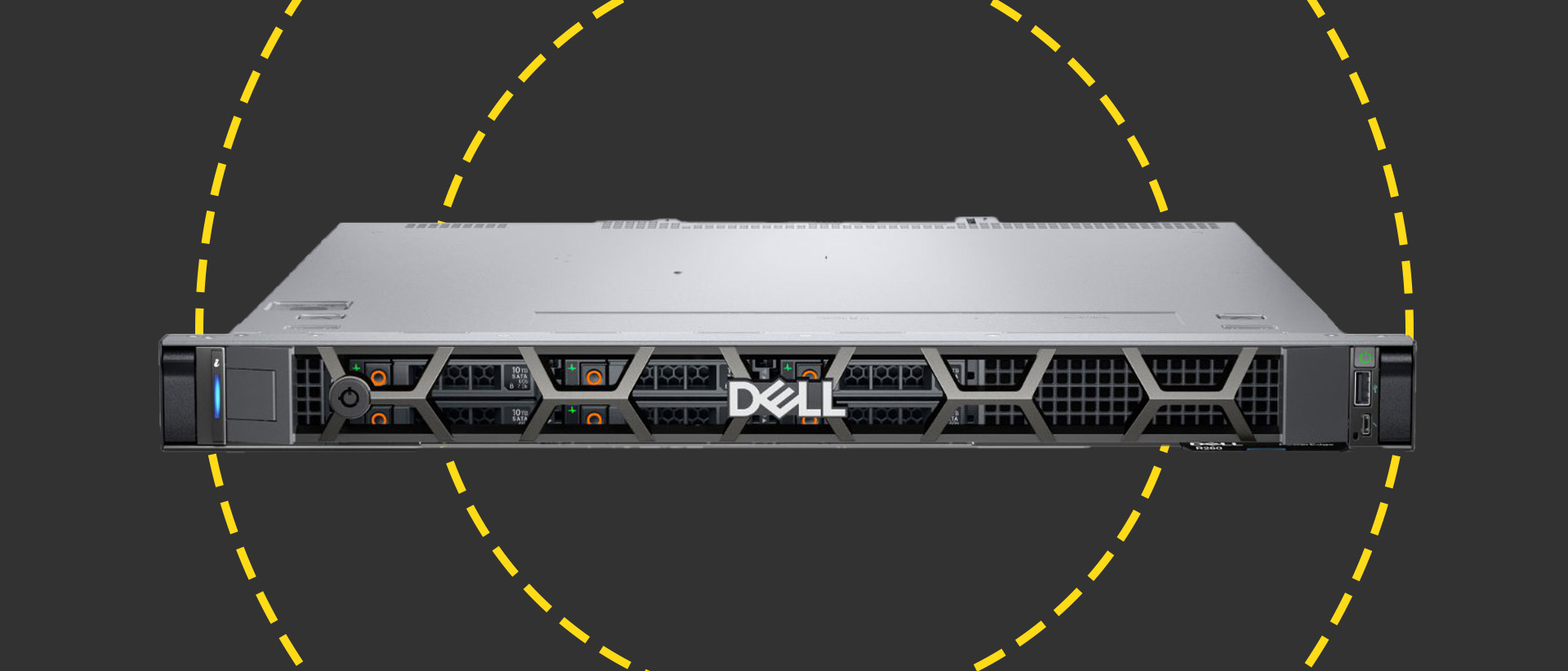Dell PowerEdge R260 review: A small and mighty rack server
Dell's little rack server packs a solid hardware punch at a price that will appeal to SMBs


-
+
Short-depth chassis
-
+
Xeon E-2400 CPUs
-
+
DDR5 memory
-
+
Improved storage options
-
+
Full-strength remote management
-
+
Good value
-
-
Nothing of note

Small businesses and remote offices seeking a compact and capable rack server will find Dell's PowerEdge R260 has a lot to offer. Designed to fit in the smallest of spaces, its short-depth 1U chassis offers a 24% footprint reduction over its predecessor, the R250.
Dell is also aiming the R260 at 'near-edge' applications such as warehouses, desktop deployments, small data cabinets, and retail offices. It can handle these harsher environments as Dell offers an optional bezel kit that incorporates a replaceable dust filter.
The small chassis doesn't compromise processing power as the R260 supports all the latest Intel Xeon E-2400 CPUs. Our system was endowed with a speedy 3.3GHz 6-core Intel Xeon E-2456 but businesses with a keen eye on costs can opt for one of two Pentium Gold G7400 dual-core models which brings the starting price down to around £1,400.
All Xeon E-2400 and Pentium G7400 CPUs support up to 128GB of memory which is the faster DDR5 variety. Storage sees improvements too, as the R260 is available with a hot-swap cage for up to six SFF HDDs or SSDs – the R250 only offers up to four LFF bays.
Dell PowerEdge R260 review: Internal design
Under the lid, you'll find a tidy interior with cable clutter kept to a minimum and easy access afforded to all key components for upgrades and maintenance. Behind the right-hand front grill are three cold-swap cooling fans that look after the CPU and four memory slots mounted further back.
We have the dual LFF drive cage which has a fourth fan behind it with Dell also offering an optional high-performance module. If you order the larger 6-bay SFF hot-swap cage, you'll receive two more standard fans which are also located behind it.
Expansion potential looks good as the R260 comes with two PCIe slots on each side of a riser with both supporting half-length, half-height cards. The server has an integral LOM (LAN on motherboard) presenting dual Gigabit ports and upgrade options are plentiful with Dell offering dual and quad-port copper Gigabit or 10GbE adapters.
You have a choice of 450W Platinum or 700W Titanium power supply units (PSUs) although most configurations only allow the latter to be selected. Redundant PSUs aren't supported but that's hardly surprising considering the size of the chassis as cooling could be an issue.

Dell PowerEdge R260 review: Storage decisions
Whichever drive cage you choose, you'll be pleased to know that the R260 has an embedded PERC S160 controller that supports software-managed stripes, mirrors, RAID10, and 5 arrays for SATA drives. The R250 has an older embedded S150 controller although its feature set is identical to the S160.
RELATED WHITEPAPER

The S160 is configured from the server's BIOS setup menu where you choose AHCI for pass-through mode or RAID. With the latter enabled you can then configure your drives for the desired RAID array type.
If you want to use SAS drives you'll need an adapter card and Dell offers three PERC 11 models. The HBA355i provides pass-through services for SAS3 and SATA drives, the H355 adds stripes and mirrors while the top-dog H755 brings RAID5, 6, 50, and 60 to the table along with 8GB of DDR4 cache memory.
Another feature we're pleased to see is the bay next to the PSU for Dell's optional BOSS-N1 card. This is the latest version which presents two hot-plug M.2 NVMe SSDs at the rear and is ideal for running an OS or hypervisor on a fault-tolerant mirrored array without wasting any front bays. In fact, one of Dell's target applications for the R260 is near-edge virtualization.
Dell PowerEdge R260 review: Management and monitoring
It may be an entry-level server but the R260 won't be found wanting for remote management services as it sports the same full-strength iDRAC9 controller as its bigger PowerEdge brothers. It presents a smart web console offering a wealth of information on system and component status, power usage, and cooling efficiency along with a hardware inventory plus direct access to BIOS and storage configurations.
We ran Dell's OpenManage Enterprise (OME) software in the lab as a Hyper-V VM and after it discovered the server's iDRAC9, we could manage and monitor it, control power, and run remote control sessions. Plenty of plug-ins are available with the Power Manager activated with an OME Enterprise Advanced license applied at the iDRAC console.

This plug-in adds a set of graphs to the OME console device view showing everything from CPU, storage, memory, fan, and FPGA power consumption to component utilization and airflow in CFM (cubic feet per minute). You can use it to enforce per-rack power cap and thermal event-based policies to automatically throttle servers back as required.
Once the server has a valid support contract, you can integrate OME with Dell's free CloudIQ cloud-hosted service. OME functions as a collector for CloudIQ, sending telemetry and alert logs to it every 15 minutes, and you can use the CloudIQ portal to view all monitored servers, storage arrays, and switches, see system health status and alerts, pull up historical trending reports and create custom dashboards. The Cybersecurity feature will prove useful as it alerts you to a wide range of potential risks such as default or weak iDRAC admin passwords, SSH access, enabled USB ports, and having a secure boot disabled.
Dell PowerEdge R260 review: Is it worth it?
With prices starting as low as a shade over £1,400, the PowerEdge R260 is an affordable entry server for SMBs and also for larger businesses that want to push compute power closer to the network edge. Despite its compact dimensions, it offers a powerful hardware package, has room for further expansion, delivers plenty of storage choices, and won't be faulted for management and monitoring services.
Dell PowerEdge R260 specifications
| Chassis | 1U short-depth rack |
| CPU | 6-core 3.3GHz Intel Xeon E-2456 |
| Memory | 16GB 4,400MT/s ECC UDIMM DDR5 (max 128GB) |
| Storage bays | 2 x cold-swap LFF (max. 6 x hot-swap SFF HDD/SSD) |
| RAID | Embedded Dell PERC S160 |
| Storage included | 2 x 16TB SATA LFF |
| Other Storage | Dell BOSS-N1 supported |
| Network | 2 x Gigabit LOM |
| Expansion | 2 x PCIe Gen4 |
| Power | 1 x 700W Titanium PSU |
| Management | Dell iDRAC9 Enterprise 16G |
| Warranty | 3Yr Basic On-Site NBD |
Get the ITPro daily newsletter
Sign up today and you will receive a free copy of our Future Focus 2025 report - the leading guidance on AI, cybersecurity and other IT challenges as per 700+ senior executives
Dave is an IT consultant and freelance journalist specialising in hands-on reviews of computer networking products covering all market sectors from small businesses to enterprises. Founder of Binary Testing Ltd – the UK’s premier independent network testing laboratory - Dave has over 45 years of experience in the IT industry.
Dave has produced many thousands of in-depth business networking product reviews from his lab which have been reproduced globally. Writing for ITPro and its sister title, PC Pro, he covers all areas of business IT infrastructure, including servers, storage, network security, data protection, cloud, infrastructure and services.
-
 ‘Phishing kits are a force multiplier': Cheap cyber crime kits can be bought on the dark web for less than $25 – and experts warn it’s lowering the barrier of entry for amateur hackers
‘Phishing kits are a force multiplier': Cheap cyber crime kits can be bought on the dark web for less than $25 – and experts warn it’s lowering the barrier of entry for amateur hackersNews Research from NordVPN shows phishing kits are now widely available on the dark web and via messaging apps like Telegram, and are often selling for less than $25.
By Emma Woollacott Published
-
 Redis unveils new tools for developers working on AI applications
Redis unveils new tools for developers working on AI applicationsNews Redis has announced new tools aimed at making it easier for AI developers to build applications and optimize large language model (LLM) outputs.
By Ross Kelly Published
-
 Google layoffs continue with "hundreds" cut from Chrome, Android, and Pixel teams
Google layoffs continue with "hundreds" cut from Chrome, Android, and Pixel teamsNews The tech giant's efficiency drive enters a third year with devices teams the latest target
By Bobby Hellard Published